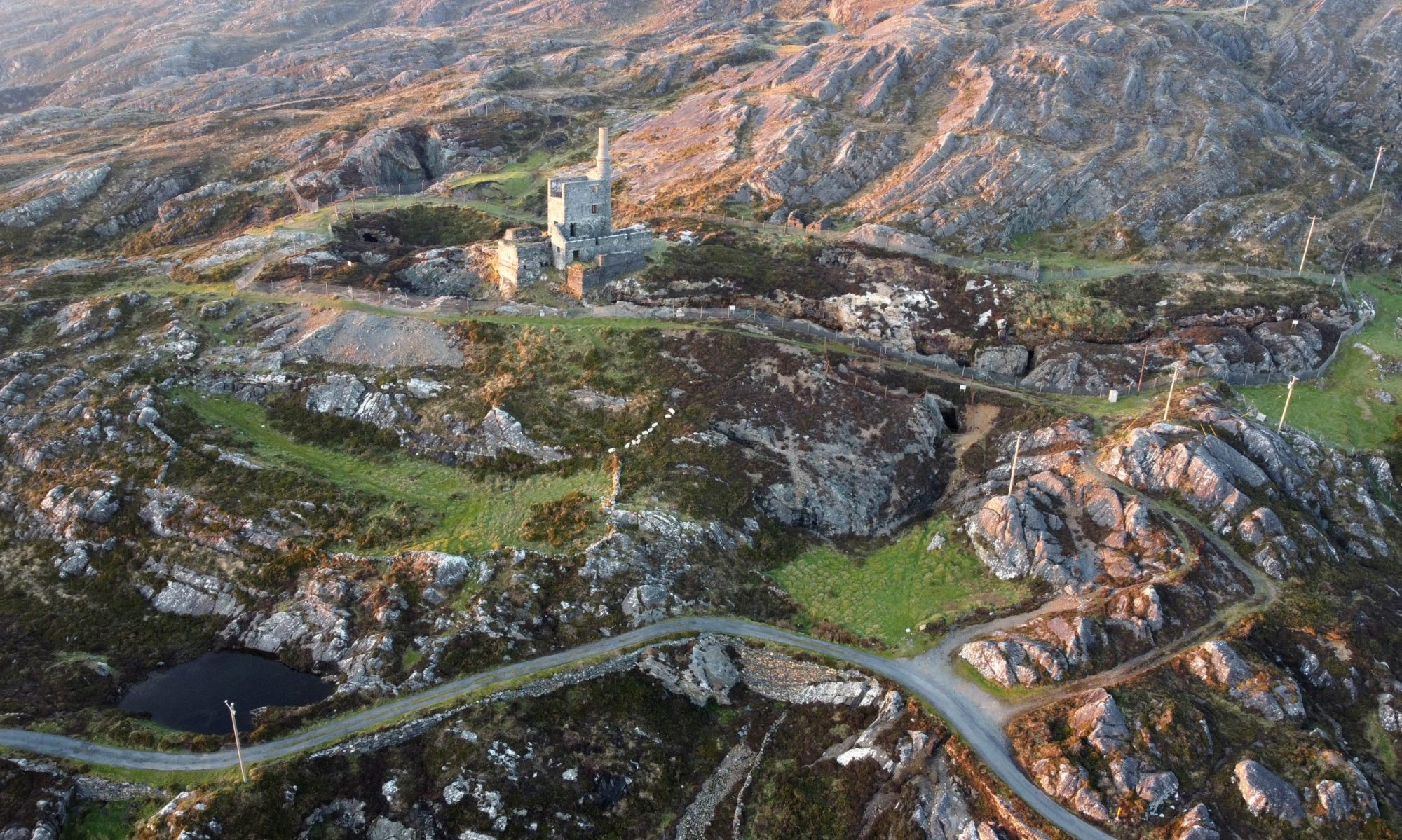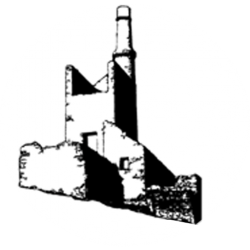The back of a massive east-west orientated quartz load paints a bright Z on the surface of the rocks above Allihies Village. The copper-rich east-west vein starts near the Cornish village and extends for 300 metres west to the southern end of the middle stroke of the “Z”, the north-south vein. The east-west vein splits 63 metres from its west end, and a subsidiary west extension vein extends for 220 metres back to the west. The north-south vein is only 60 metres long but was very productive. The minor new east-west vein extends 235 metres west of the northern end of the middle stroke of the “Z”, and a fault probably connects it to Dooneen. Mountain mine started along the back of the load as an open cast mine. Later on two adits were driven at lower levels through the mountain side into the load and several shafts were sunk for winding and drainage. The 1862 built Man engine house stands beside the western end of the open cast. Conservation was carried out by the MHTI in 2004. The scant remains of the North engine house occur at the north end of the north-south vein. This engine was a pumping engine erected in 1930. The early open-cast works are still obvious, with the ruined Cornish Village at their west end (one house rebuilt). A fine gunpowder magazine is preserved in a rocky hollow below the Cornish Village. Below the Man engine house are ore dressing floors and the foundations of various early 20th century mine buildings below the main adit. The 19th century dressing floors and steam-driven stamping houses were north of the road below.
A BRIEF HISTORY
| 1813 | (Spring) Mountain lode discovered and (June) mine opened. (August) Construction of roads and buildings commences. Mining of the east-west vein and west extension vein by open-cast quarrying begins but flooding from rainfall leads to two adits being driven into the mountainside (- 1814). First shipment of 75 tons of ore takes place. | |
| 1814 | Eight cargoes shipped from Ballydonegan Bay, totalling 300 tons of ore. | |
| 1815 | Continued surface flooding forces mining underground. At least 10 cargoes shipped, totalling 650 tons of ore. | |
| 1818 | Water-powered stamping mills erected. | |
| 1819 | The north-south vein (north lode) now becomes the main support of the mine. A horse whim is installed underground to increase the volume of ore removed. | |
| 1820 | North lode tramway completed, replacing wheelbarrows. | |
| 1822 | (June) Puxley believes mine on its last legs and his interest returns to Dooneen. | |
| 1823 | (February) The mine revives… but not the north lode. | |
| 1824 | (February) The east-west lode (vein) now looking very favourable. (November) North lode supporting mine again. | |
| 1825 | (August) The east-west lode scarcely worth working. | |
| 1828 | (November) The north lode, until now supporting the mine, fails. | |
| 1829 | (August) The north lode improves. | |
| 1830 | (April) Foundations for North engine house (pumping engine) cleared at north end of north lode. (July). 30″ steam engine, purchased from Neath Abbey Co. in South Wales for £736, | |
| 1831 | (January) Ground cleared at foot of mine for new roller crusher engine house for crushing ore (because of labour shortages and to save on labour costs). A 30″ steam engine bought from Neath Abbey Co. for £1,135 together with machinery for a further £600. (March). Mining activities curtailed when Government restricts gunpowder supply; gunpowder magazine strengthened with a concentric, 30″ outer wall and double doors. (June) Engine landed, erected (August) and in operation (October), replacing all mine “buckers”. | |
| 1833 | Mine very productive. | |
| 1834 | Head mine manager’s house built; Cornish Village begun for other managers. | |
| 1835 | (March) platforms cut at 28 fathoms for underground whim steam engine in North lode; boilers installed (November) and engine erected (December). | |
| 1848 | Detailed mine records end. | |
| 1862 | Man engine shaft sunk and 36″ Man steam engine installed near west end of east-west lode to haul ore from ever-deeper levels (too deep for horse-drawn whims) to the adit level 45 metres below. (Mining finally stopped 421 metres below surface.) | |
| 1868 | Henry Puxley sells the mines; new Berehaven Mining Company continues mining. | |
| 1872 | Mountain mine production remains mainstay of mining operations. | |
| 1876 | Mine still showing a profit (- 1877). | |
| 1878 | Mountain mine employs 106 men, with returns just paying its costs. | |
| 1882 | (February) Mine worked out; closes (mid-year). | |
| 1902 | Two adits driven into Marion lode, above Mountain Mine, by new Berehaven Copper Mine Ltd. | |
| 1919 | (October) New Allihies Copper Mines Ltd removes a little ore from accessible workings. | |
| 1920 | British Army removes explosives and mining ceases. | |
| 1923 | (- 1924) Large crushing mill, forge, offices, storehouses, assay office, concentrate stores and accommodation constructed below the main adit. | |
| 1927 | (February) Fifty men employed in resumed mining. (June) A new shaft being driven. | |
| 1928 | Mine partially dewatered by new owners, British Non-ferrous Metals Corporation. | |
| 1929 | First 100 tons of 24% copper ore concentrate shipped to Swansea from Castletown. | |
| 1930 | 2,251 tons of copper concentrate shipped out. Working at great loss and closes (June). | |
| 1956 | New Emerald Isle Mining Company begins investigations with a view to reopening mine. | |
| 1957 | (March-) Mine dewatered (two years of pumping). Extensive diamond drilling reveals 1.5 million tons of 1.9% copper ore, extending down to 686 metres. | |
| 1961 | Further program of diamond drilling. Ore considered sub-economic. | |
| 1962 | (February) Operations suspended and mine allowed to flood again. |

